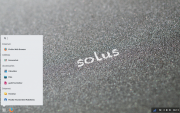Five Linux desktop distributions with a great future
If you're looking for a new Linux distribution, don't let the choices overwhelm you. This list of rising distributions will get you off to a great start.
By Jack Wallen in Five Apps, July 14, 2015, 10:24 AM PST
Linux is everywhere. It's on your servers and in your phones, cars, watches, toasters, refrigerators... and desktops. Although fewer users see Linux on their desktops than in their thermostats, even that is on the rise, partly due to the number of high-quality distributions. This new wave of Linux desktop distributions is bringing a confluence of user-friendliness, modern design, and stability to the open source platform.
The only problem you might have is figuring out which of the more recent distributions are the true darlings of the moment. Never fear, intrepid readers: I have you covered with the five Linux desktop distributions I feel are the hottest commodities coming out of the open source world.
1: Elementary OS Freya
Elementary OS Freya (Figure A) is the first Linux distribution in a long time to seduce me away from my long-time favorite, Ubuntu. There's a good reason for this.
Elementary offers a perfect combination of modernity and old-school Linux. More than anything, users will appreciate how much thought was put into keeping a uniform look and feel across the board.
 Figure A
Figure A
All apps carry a similar design spec and do exactly what you'd expect them to do. With Elementary OS Freya, there are no surprises. It works and it works impeccably.
Anyone who has used Windows or OS X will immediately be at home in Freya. It's that well designed. Yet it doesn't give up its own unique flavor and design elements.
2: Chromixium
Chromixium (Figure B) is one of two Chrome OS-like distributions on this list. Chrome OS has managed to do something no other OS has done: bombproof the operating system. But some users are put off by the idea that Chrome OS has a certain local-app limitation. That's where distributions like Chromixium come into play.
 Figure B
Figure B
Working with standard hardware, Chromixium allows you to enjoy a Chrome OS experience without having to purchase new hardware. Oh, and you can run all the great apps available for Linux. LibreOffice? No problem. Gimp? No problem. OpenShot, Scribus, Audacity, Ardour, Thunderbird... the list goes on and on. If you're looking for the elegant simplicity of Chrome OS and the power of Linux, give this distribution a try.
3: Solus
Solus (Figure C) was, at one point, Evolve OS. But a trademark spat between the developers and the UK Secretary of State Office caused the shift in name. Solus is the second Chrome OS-like distribution in the list. (I can't help it; I'm a fan of Chrome OS.) But where Chromixium might seem to struggle a bit in keeping every element congruent with the design, Solus succeeds on an Elementary OS Freya level.
 Figure C
Figure C
Add to this the developer's desire to ensure zero scope creep and Solus is a project everyone should be watching. The desktop is centered on a built-from-scratch environment called Budgie, which does an outstanding job of keeping things simple. As you might expect, Solus is still in beta and development is on the slow side of things. Even so, keep your eyes glued to this distribution. When it comes out of beta, look out!
4: Korora
Korora (Figure D) is a re-spin of the Fedora project that "just works" out of the box. This distribution takes the bleeding edge Fedora, tones it down a bit, includes the necessary codecs for multimedia, and even allows you to select which desktop you want during install (Cinnamon, GNOME, KDE, Mate, or XFCE). Korora also preconfigures a few repositories the developers think most users would want (Adobe Flash, Dropbox, Google Chrome/Earth/Talk, RPMFusion, VirtualBox).
 Figure D
Figure D
Korora developers are working on a unique tool called Lens. This project has a goal of creating an agnostic alternative to desktop UIs. It's actually a fairly impressive (and complex) idea, which you can read more about here.
5: Mageia
Mageia (Figure E) isn't new, but it's managed to remain under the radar since its inception in 2010. Mageia was given life as a fork of the now-defunct Mandriva Linux.
Not only does Mageia promise to deliver a secure, solid, and sustainable operating system, it also brings about a stable and trustable governance of the platform: something other open source projects are having issues with. You can download KDE or GNOME versions of Mageia and know that neither will throw any surprises at you. What you expect, is what you get: it's simple, reliable, and stable software.
 Figure E
Figure E
Mageia should be much applauded for the thriving community it has developed (and continues to nurture). I strongly believe that Mageia could become one of the primary distributions for those looking to run either the GNOME or KDE desktop.
Your choice?
There are so many Linux distributions, deciding which one to try can seem overwhelming. I believe each of these distributions will see quite a bit of attention in the coming years. Without fail, I would gladly recommend each of these for new and experienced users alike. Give one of these Linux distributions a try and see if it doesn't meet your needs.